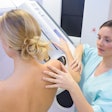
A breast cancer diagnosis is almost the same as a death sentence for women in some low-income countries, where survival rates are as low as 3.5%. But it doesn't have to be this way, if more investments were made in treatment and imaging, according to a simulation study published August 17 inThe Lancet Oncology.
Researchers led by Zachary Ward, PhD, from Harvard University's T.H. Chan School of Public Health performed a simulation model to assess the impact of investment in imaging technologies and improving quality of care on global five-year net breast cancer survival.
They found that such investments would improve global survival rates by nearly 15% and have an even bigger impact on low- and middle-income countries, where breast cancer survival rates lag badly.
"We found that breast cancer outcomes vary substantially by country income group and geographical region, with a much worse stage at diagnosis in lower-income settings and a 25-times difference in survival between low-income and high-income countries," Ward and colleagues wrote.
Globally, the five-year breast cancer survival rate stood at 67.9% in 2018. But that figure varied widely around the world, from 3.5% in low-income countries to 87% in high-income countries. countries.
Much of the difference is because women in low-income and middle-income countries face barriers to breast cancer care and have poor survival outcomes. The researchers said that improvements in breast cancer mortality rates in high-income countries are largely due to improvements in early detection and adjuvant systemic therapy.
Women in low-income and middle-income countries present with advanced-stage breast cancer, researchers say, due to delays in diagnosis associated with barriers at both the patient and health system levels. These include lack of education, reliance on traditional methods, and lack of access to diagnostic imaging, among others.
The research team wanted to see how investments in treatment availability and imaging methods would impact breast cancer survival, as well as improvements in quality of care. Using a simulation-based analysis, the team modeled stage-specific breast cancer survival for newly diagnosed patients in 2018 in 200 countries and territories.
The model takes several imaging technologies and treatment methods into account. These include chemotherapy, radiotherapy, surgery, ultrasound, CT, MRI and x-ray, among others. The model also simulates quality of care by looking at health-system and facility-level factors that account for residual differences in survival not explained by cancer stage or treatment and imaging availability.
Scaling up access to surgery was found to yield the largest survival gains globally (+2.7%) and scaling up CT would have the largest global impact among imaging modalities (+0.5%).
The team also found scaling up a package of traditional methods, including surgery, chemotherapy, radiotherapy, ultrasound, and x-ray could improve global five-year net survival to 75.6%. Survival in low-income countries would improve from 3.5% to 28.6%.
Ward and colleagues said these improvements could provide a more feasible pathway to improving breast cancer survival in these settings even without the benefits of future investments in targeted therapy and advanced imaging.
"Adding concurrent improvements in quality of care could further improve global five-year net survival to 78.2%, with a substantial impact in low-income countries, improving net survival to 55.3%," the study authors wrote. "Comprehensive scale-up of access to all modalities and improvements in quality of care could improve global five-year net survival to 82.3%."
However, the impact on survival of expanding the availability of any single imaging or treatment method other than surgery was found to be "relatively modest," even in lower-income countries. The researchers said more comprehensive packages of scale-up will be needed to substantially improve breast cancer survival globally.



















